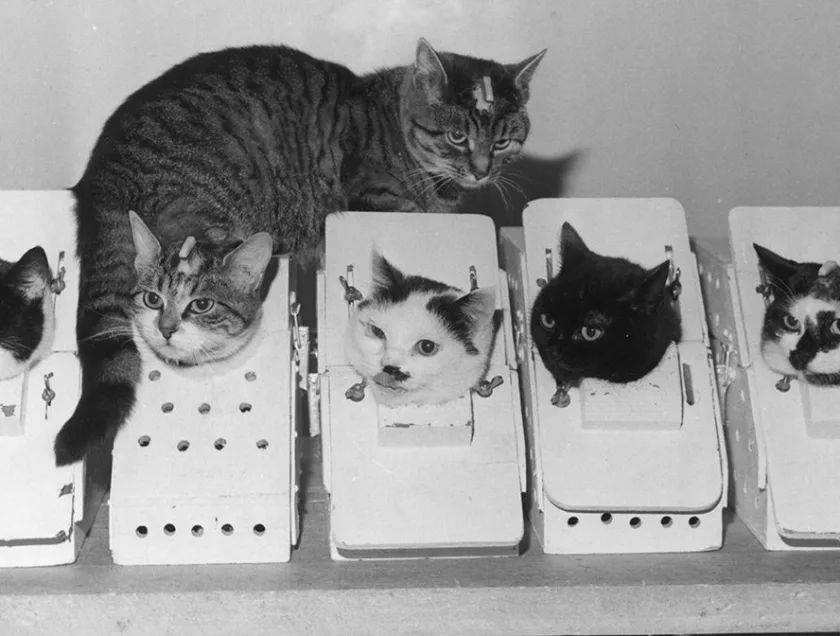During the early years of space flight, animals were frequently flown into space and their bodies examined to investigate the various physiological effects microgravity and space flight might have on them. Most space agencies involved in these experiments chose rats, dogs, and monkeys. The French chose cats. The purpose of these experiments was to study the neurological effects of space travel, and the French scientists already had a significant amount of neurological data on felines.

One of the many cats shortlisted for the flight, strapped to a restraining apparatus that would be used on rocket flight. Photo: G. Chatelier/CERMA
In 1963, the Centre d'Enseignement et de Recherches de Médecine Aéronautique (CERMA) purchased fourteen cats from a pet dealer, all of which were presumably rescued from the streets. The cats were selected based on their temperament, and all of them were female.
The cats were subjected to a regime of strenuous training, which included being whirled in centrifuges to determine their tolerance to high g-forces and spending time in compression chambers. The cats also spent time enclosed in noise boxes to allow project scientists to assess each animal’s reaction to a variety of sounds they might hear during a launch.
In order to prevent the staff from becoming emotionally attached to the cats during their training, none of the cats were named. Instead, they were given serial numbers. One of the cats designated C 341 came through the ordeals without sufferings undue stress, despite having underwent a 10-hour-long operations during which she was surgically implanted with electrodes in her skull and brain to monitor neurological activity. The electrophysiological recordings would be far more comprehensive than those achievable with smaller rats, taking in data from the front sinus, the ventral hippocampal, the reticular area, and the cortex.

On 18 October 1963, C 341 was strapped into the nose section of a Véronique AGI 47 sounding rocket and sent aloft from the Colomb Bacar rocket base at Hammaguir in Algeria. The rocket engine burned for 42 seconds on ascent and C 341 experienced 9.5 g of acceleration. The rocket and its nose cone containing C 341 separated on schedule, and the nose cone continued to penetrate the ionosphere until it reached an altitude of 152 kilometers. There, the nose cone floated in weightlessness for approximately five minutes before tumbling back to earth. The entire flight lasted less than 15 minutes.
C 341 was collected from her pod. She had survived the flight without incident. Throughout the flight, the electrodes implanted into her brain sent valuable data back to earth. After the details of her flight became known to the media, an unknown journalist gave her the name “Felix”, after the Félix the Cat cartoon series. CERMA changed it to the feminine Félicette and adopted the name as official. Two months later, Félicette was killed so that her brain could be examined.

Felicette being weighed on the scales. Photo: IMAGO / United Archives
A second cat whose name was never released went on another flight on 24 October, but the launch went wrong right from the start and the capsule containing the cat crashed back to earth killing its sole occupant. That was the last time anyone sent cats to space.
Although Félicette’s participation was a huge milestone for France, her flight didn't not receive much publicity. Writers Colin Burgess and Chris Dubbs believes this was because of her photographs showing Félicette with electrodes protruding from her skull that were far from appealing to readers, especially those involved in the new animal rights movement. However, she did get a few stamps commemorating her flight that were released by some former French colonies in the 1990s. Unfortunately, her name was misspelt as “Felix”.
It wasn’t until half a century later that Félicette got a proper monument, a statue that was unveiled in December 2019 at the International Space University in Strasbourg, France. The statue was possible due to a crowdfunding effort launched by Matthew Serge Guy that managed to raise £40,000 through a Kickstarter campaign. The five-foot-tall statue, designed by sculptor Gill Parker, depicts Félicette perched atop Earth, gazing up toward the skies.












Comments
Post a Comment